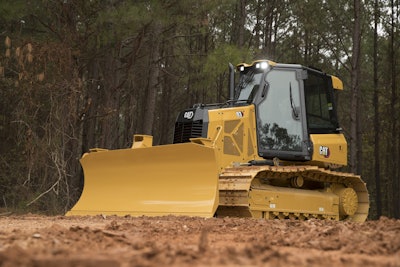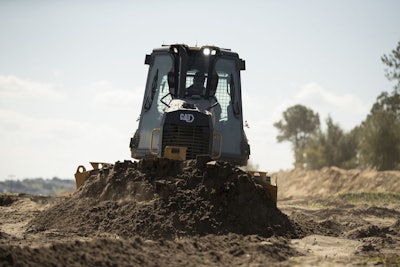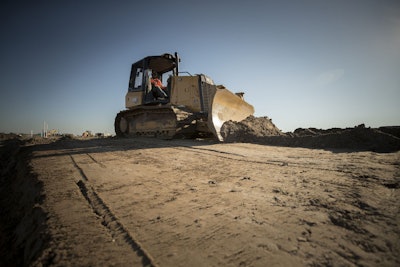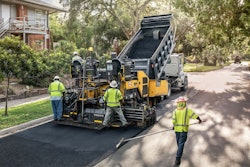The Caterpillar small dozer lineup has been rethought. Gone are the D3K2, D4K2 and D5K2 and in their place are the new D1, D2 and D3. In the video below, we break down the differences between the new machines and their predecessors and discuss Cat’s motivation behind the new model names.
Back in 2017, Cat began a pretty significant overhaul of its system for naming machines. Specifically, they started dropping letter modifiers from model names. For instance, the latest Cat 330 excavator is just the 330 now, replacing the 330F. The new 420 backhoe replaced the 420F2.
Starting in 2018, this new naming convention extended into Cat’s dozer lineup as the company started introducing its next generation dozers. The new D6 was the first dozer to receive the treatment in replacing what was the D6T. Then the D5 was launched, replacing the D6N. And at ConExpo the D7 was launched replacing the D7E and D7R.
These are more than simple model name changes. They’re really a restructuring of the Cat dozer lineup. Now the change has come to Cat’s small dozer lineup with the introduction of three new models: the D1, D2 and D3.
What’s in a name?
 The new Cat D3
The new Cat D3As recently as a couple months ago, the machine now called the D4 was the D6K2. For all intents and purposes, it’s still the D6K2. Same engine, same cab, same specs, same everything. Except for the name.
And a big reason that Cat changed the name of that machine to the D4 are the new Cat D1, D2 and D3.
Cat hopes that all of these new dozer model names will allow you to quickly recall how powerful each new dozer is and place where it fits in the lineup in terms of power and capability.
Under the new nomenclature, the new D1 replaces the old D3K2, the D2 replaces the D4K2 and the D3 replaces the D5K2.
A little bit of triva for you, the D1 is an all new model name for a Cat dozer. So if you grab one of these, you’ll be buying a bit of history. The D2, however is a throwback. Cat offered a D2 dozer between 1938 and 1957.
So, going back to the new D4 we mentioned earlier, since the new naming system for dozers only allows for one model per size class, that means the D6K2 would have fallen between the D3 and D5 in terms of size and capability. So, Cat changed the name to the D4 for obvious reasons.
“One thing we really do at Caterpillar, we listen to our customers and our customers were telling us we needed to try to simplify our nomenclature somehow,” says Joel Fritts, Caterpillar product application specialist for small dozers. “So we came up with this solution. We thought it was the best and that it preserved our brand equity. There’s a lot of heritage in the “D” nomenclature. That was our number one objective. So that’s how we wound up with this very simple model nomenclature, which basically from a D6 down, we’ve moved the numbers down a little bit. And while there’s a little concern there [from customers], in the long run, after we get through this adjustment period, I think it’s going to be a lot simpler for everyone to understand what size Cat dozer they need to do the work.”
And while we didn’t anything new to talk about with the D4, there’s plenty of new stuff to talk about with the new D1, D2 and D3.
New design
Beyond all the new model names, the next big change with these three new small dozers is their new look. In addition to being adorned with the new Cat logo and model badges, now complemented with that new hexagon design, these dozers also feature styling changes.
Specifically, the machines feature a redesigned hood that slopes lower toward the ground. Cat says this change provides 30 percent more visibility both over the hood to the blade and to the operator’s peripheral views.
Plus, Cat says that lower hood design was made possible by a new engine for this part of the dozer range.
New engine
The new Cat C3.6 engine provides quite a bit of space savings found through its more compact packaging and thanks to a bit of rearranging Cat engineers did with the engine components.
That Cat C3.6 engine is also notable because Cat is using it across a wide range of smaller equipment, including most of its Building Construction Products lineup of compact machines including backhoes, compact wheel loaders and more. That provides quite a bit of commonality for servicing.
But emissions and fuel economy are two other major factors in the switch to the C3.6 for Cat’s smallest dozers.
“We went with the new C3.6 primarily to meet our emission requirement for Europe with Stage Five,” Fritts says. “And it still met all the requirements for Tier Four in other areas of the world.”
Though Cat has switched from its C4.4 engine to the new C3.6 engine, these new small dozers retain the horsepower ratings of the machines they replace. The D1 remains at 80 hp, the D2 at 92 and the D3 at 104 hp. Thanks to the new engine however, the new dozers can deliver fuel savings of up to 10 percent.
“I know sometimes there is some concern with the smaller size of an engine changing displacement. And I would just like to address that a little bit,” Fritts says. “It’s very similar to the automobile industry or truck industry. Today with the control systems that we have on both engines and transmissions, the two can communicate together so much better than what we had in the former days where you had a manual transmission and you had to depend on engine torque, for example, to change with the transient loads the machine or the vehicle may see.
“But today with the control systems we have that becomes less critical,” Fritts explained. “So we’re able to use a little bit smaller displacement engines, get the horsepower we need from it very economically, primarily with some great machining and new designs that allow that machine to operate for a lot longer period of time than what some of these former engines used to. And so it’s a just a better overall combination when we go to these newer high tech engine and transmission solutions.”
Undercarriage and footprint unchanged

Now, part of the naming change we discussed earlier is dropping the XL designation that existed on the older models. However, two undercarriage configurations will still be available in standard and LGP or low ground pressure.
The D1 and D2 have 89 inches of track on the ground while the D3 has 91 inches.
A 30-inch LGP track will be offered on the D1 and D3. You’ll also be able to choose between sealed and lubricated track and Cat Abrasion undercarriage systems.
The new models also have the same weight and dimensions as their predecessors and retain many of the standard features those older models had including an ECO mode, auto traction control, stable blade and slope indicate.
For those wondering whether Cat will continue to offer the mulching attachments offered on the D3K models on the new D1, they’ll be available later this year.
The D1 ranges in operating weight between 18,240 and 18,390 pounds. The D2 ranges between 18,340 and 19,019 pounds. The D3 ranges between 20,321 and 21,150 pounds.
Technology and maintenance

Though Cat’s latest machines are coming packed with new technology, the heavy equipment maker admits that enabling these time saving features and functions has not always been easy or obvious. The company is trying to change that with an optional new 10-inch touchscreen display.
“You know, you can put all this technology on a machine, but if the operator cannot take advantage of it and actually use it, it really serves no value to the customer and getting their work done,” Fritts says. “So in doing that, we came up with some easier user interface, a new display, for example, that’s consistent across all of our tractor lines. These models make it easier to use these new features we have for grade control like slope assist, Cat GRADE with 2D and GRADE with 3D.”
Other optional equipment includes Cat Grade Slope Assist, Cat Grade 3D, a ventilated seat, heated controls, and Power Pitch, a feature that allows the operator to control blade pitch from the cab.
On the maintenance side, the dozers feature a large, hinged door for easy engine service access to all regular engine maintenance points. This door has been moved to the right hand side of the new machines.
An optional turbine-type pre-cleaner works to increase engine air filter lifte when working in conditions with excess debris. Another available option is an automatic reversing fan for blowing out debris build-up in the radiator and engine enclosure. And if you want to access the radiator without tools for periodic cleaning, the new hinged radiator grille is another available option.











